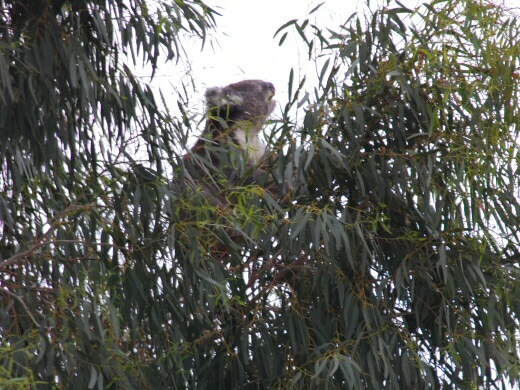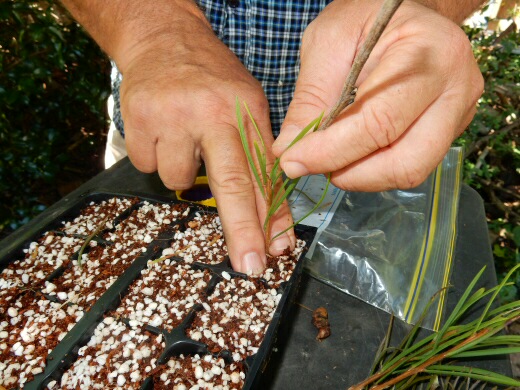SUMMER FUN
Another month of summer weather to go, and we are counting down the days till the milder temperatures of autumn kick in. Holidays and relaxation are finishing too, kids are going back to school, so it’s a great time for various plant related activities.
Bushwalking is a must-do activity at any time of the year, and late summer is good for exploring some of our great coastal walks. The last of the hot weather is tempered by cooling sea breezes, and there are some interesting plants around in bloom, like felty flannel flowers and big, bold banksias. I’m sharing my latest bushwalk extravaganza on Kangaroo Island this month.
Summer weather is great plant propagation time, so I hope to inspire you to have a go at growing some new plants from cuttings in this newsletter. Next newsletter I will show you how to propagate clumping perennials like kangaroo paws by division.
And Valentines Day is fast approaching. I know that my native plant fans have too much flair for tired old roses (mostly now imported from overseas anyway), so this day for lovers should feature………garlic! Yes, February the 14th, come to Koonya, Tasmania for the fabulous garlic festival. My good friend Tino Carnivale and I will be giving a talk, there will be music and cooking demonstrations. Now, I know you want more-
How about garlic and spoon racing, and a garlic pinata? I’ll see you there!
KANGAROO ISLAND BUSHWALKING
I recently visited Kangaroo Island for some late summer fun, and what a fabulous place for catching sea breezes while getting amongst some great Aussie native flora, fauna and stunning scenery. It is the third largest of Australia’s islands, and being one of the southern most extremities, is home to seal colonies, penguins, the Cape Barren goose, cute Parma wallabies, koalas, and, no surprise here, kangaroos.
A third of the island is National and Conservative Park land, making it a real national treasure. Plus it is great for good food lovers, being home to wineries and farm gate producers. Photography enthusiasts have plenty to capture too, like Remarkable Rocks, limestone caves, Admirals Arch and so much more.
The island is based on metamorphic rock, overlaid with limestone, creating some wonderful forms. As this breaks down it creates a limey soil. This, coupled with windswept coastline, means that Kangaroo Island is home to some interesting endemic plants. Close to the coast there are wonderful natural bonsai forms of Melaleuca, cushion bush, Correas and our native succulents like Carpobrotus and Disphyma. There are lots more around the island, like mallee eucalypts, a sterile hakea that only reproduces by suckers, pea flowers, delicate orchids…….a native plant lovers delight.
PROPAGATING BY CUTTINGS
Reproducing a plant by cuttings is one gardening skill that is part magic and all science. Seed will give a plant that may be different from the parent, but by taking cutting, you can produce an exact genetic copy. If we couldn’t grow from cuttings, we wouldn’t be able to share unique plants more widely. And the various forms of vegetative propagation gives plant breeders incentive to work away at ever better forms for our gardens!
Cuttings are useful for reproducing perennial plants, woody shrubs, and some trees. Go outside and take a look at actively growing shrubs and plants to observe what you can use as a cutting. If the plant is in fresh growth, the ends of the branches will be softer and very flexible and will look a fresher colour. This can be used for tip cuttings. If you look further along the branch to where the growth is maturing, and give it a feel, you will notice that the growth becomes harder, the bark feels more dense and solid, and it is less flexible- this would be suitable for semi hardwood cuttings. Further into the plant, as the area of the branch gets to a year or more old, it becomes mature and hard, and this is your hardwood cutting. Tip cuttings are good to use if you don’t have any rooting hormone, but they need more careful handling as they are more delicate.
Cuttings can be helped along with the addition of rooting hormones, which is where science comes to our aid. The discovery of plant hormones has given us better control of various areas of plant growth. And while there are some plants which will make root growth easily, in some cases even when left in a jar of water, for most plants the use of rooting hormones will ensure a faster result with a stronger root system being formed.
So let’s get stuck into it!
First, find the plant you want to reproduce. The pictures show cuttings from a very nice, compact and hardy Callistemon that I am developing for future release. The material I am working on is semi hardwood….spring growth that has now matured enough so that the cuttings are no longer soft and tender. You can buy rooting hormone in gel or powder form from nurseries and hardware sections. It is light and heat sensitive, so I keep mine in the fridge, well labeled of course- safety first! Always tip enough hormone into a separate container, and don’t tip the excess back in after you’ve finished, as this can contaminate the unused portion.
Prepare a tray to put your cuttings in…..the media used for propagation is very important for success. I use a light and fluffy mix of coco peat (which is a sustainable resource made from coconut husks), coarse sand, perlite and vermiculite, in equal quantities. If your mix is too dense and compact, then results will not be as good.
Use nice sharp and clean secateurs to take your cuttings.
Gently pull off the lower leaves from the prepared cutting. Note that ziplock bags are very handy to transport cuttings so they don’t dry out.
If you look closely, you can see that I have taken a very thin scraping from the lower bark- this helps the hormone to penetrate.
Use a dibble stick (any straight stick will do- this one was a handy thin twig) to make the right sized hole for the cutting
Dipping into the rooting hormone- this one is a gel, which will stick a good layer of hormone to the cutting surface
Lightly firm the soil around the cutting
Ta-da! Twenty new exact replicas of the mother plant. Twenty potential shrubs. It really does have a touch of magic when you discover that you can grow your own plants.
The next important step is to place the cuttings into an environment where the surrounding air will maintain a good level of humidity. These ones are going into a large greenhouse. If you don’t have a greenhouse, you can fashion a smaller space by using a clear plastic crate, which are easily found- put a layer of gravel or sand on the bottom which can be kept damp and so the pot doesn’t sit directly in water. You can also cut a clear plastic bottle in half, put damp soil in the bottom half, and the top half becomes the lid- this makes an excellent mini greenhouse for just a few cuttings.
Be patient, and check regularly to keep the soil moist but not wet. Be sure the cuttings don’t dry out or get too wet for a prolonged period, and you too can become a plant propagator!
My book, Let’s Propagate, has much more in depth information on all methods of propagation- available from my online shop now>>>











